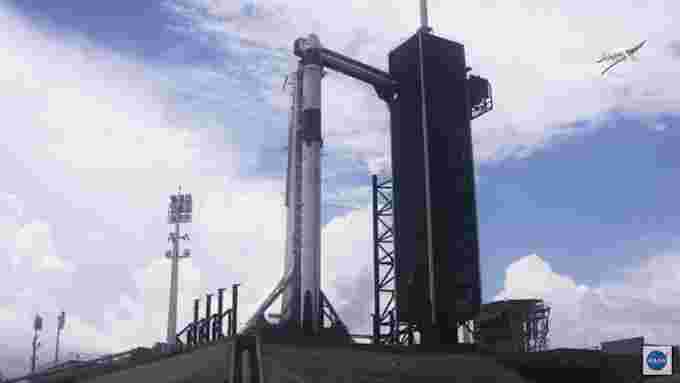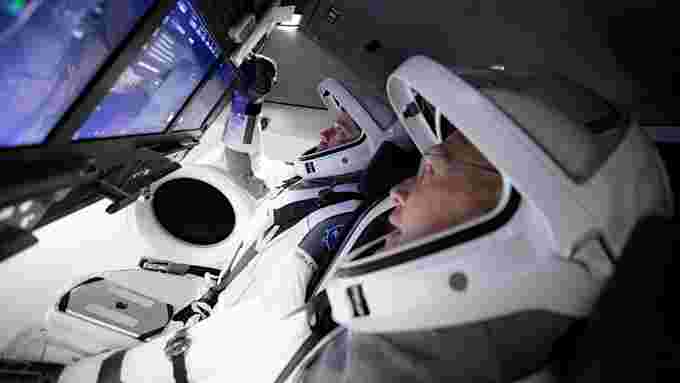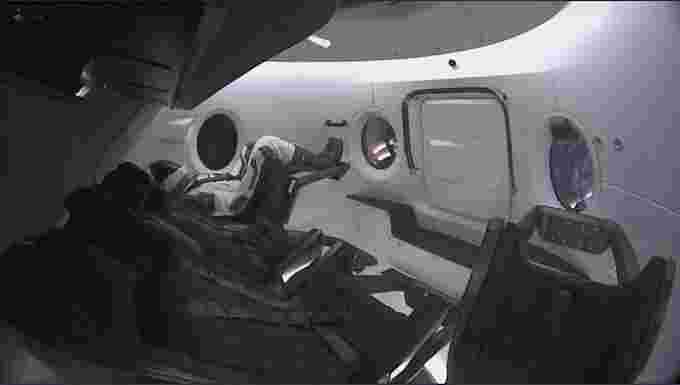After being delayed by weather earlier this week, NASA and SpaceX are ready for another attempt at making history.
The Crew Dragon spacecraft sits atop a Falcon 9 booster rocket from Kennedy Space Center's historic Launch Complex 39A, waiting for NASA astronauts Bob Behnken & Doug Hurley and its Saturday afternoon lift-off. This Demo-2 mission will be history-making in two ways. First, this will be the first-ever commercial launch to carry astronauts to the International Space Station. Second, it will be the first crewed launch from American soil since the Space Shuttle program ended nearly a decade ago.
"We are so proud and happy for Doug and Bob," astronaut Nicole Mann, who is slated to fly on a future commercial launch on Boeing's Starliner spacecraft, said in a NASA statement. "It feels kind of like one of your close family members having a great lifetime achievement — and really, that's what it is."
The instantaneous launch window for this important mission is scheduled to reach 'T-minus zero' at 3:22 p.m. EDT on Saturday, May 30, 2020. Watch below for full coverage.
According to NASA: "Full mission coverage begins at 11 a.m., and will air live on NASA Television and the agency's website, as well as numerous other platforms. The launch broadcast commentators are: Marie Lewis, Dan Huot, Gary Jordan, Derrol Nail, and Tahira Allen from NASA; and Lauren Lyons, John Insprucker, and Jessie Anderson from SpaceX; with special guest host and former NASA astronaut Leland Melvin. Postlaunch coverage commentators are Leah Cheshier, Courtney Beasley, Gary Jordan and Dan Huot from NASA; and Kate Tice, Siva Bharadvaj, and Michael Andrews from SpaceX."
If all goes as planned, the Falcon 9 booster will complete the journey, carrying Behnken and Hurley onboard Crew Dragon to orbit in just under 9 minutes. They will then be on-route for a rendezvous with the International Space Station at 10:29 a.m. Sunday, May 31.
By the time the astronauts get to experience the weightlessness of being in orbit, the 1st stage of the Falcon 9 rocket will already be moments away from setting down on the droneship "Of Course I Still Love You", out on the Atlantic Ocean.
 SpaceX's flight profile for the Demo-2 mission. The Crew Dragon is expected to reach orbit in just 8 minutes and 47 seconds after lift-off, while the Falcon 8 1st stage is scheduled to touch down at 9 minutes, 22 seconds after launch. Credit: NASA TV
SpaceX's flight profile for the Demo-2 mission. The Crew Dragon is expected to reach orbit in just 8 minutes and 47 seconds after lift-off, while the Falcon 8 1st stage is scheduled to touch down at 9 minutes, 22 seconds after launch. Credit: NASA TV
A 'launch window' is the time set by ground controllers so a rocket can lift off and be in the best position to complete its mission. Often, once a launch window opens, there is a certain amount of time they can delay lift-off, and the rocket can still accomplish its task. Other missions, such as Demo-2, have an 'instantaneous' launch window. This means that the rocket must lift off at the exact moment the timer reaches T-zero. Otherwise, the attempt must be aborted for that day and delayed until the next launch window opens.
If Demo-2 cannot launch on Saturday, due to technical issues or active weather, NASA and SpaceX have set an alternative launch window for 3 p.m. EDT on Sunday, May 31.
 SpaceX Demo-1 performed flawlessly on launch and arrival to the International Space Station back on March 2, 2019. Credit: NASA TV
SpaceX Demo-1 performed flawlessly on launch and arrival to the International Space Station back on March 2, 2019. Credit: NASA TV
WEATHER OR NOT
The updated weather forecast from the U.S. Air Force's 45th Weather Squadron, as of Friday morning, is similar to what they were saying for Wednesday. There is a 50 per cent chance of favourable conditions for Saturday's Demo-2 launch attempt, with the primary weather concerns being the potential for cumulus or cumulonimbus (anvil) clouds in the vicinity of the launch site, and the possibility of the rocket flying through precipitation.
Cumulus or cumulonimbus clouds near the launch site would indicate the presence of turbulence and possibly strong upper-level wind shear. These conditions could disrupt the rocket's flight path, overtax its structural integrity or force it to consume too much fuel. Flying through precipitation raises the risk of the rocket gathering a static charge during flight, which could attract a lightning strike from nearby clouds.
Read: Lightning strikes almost doomed the 1969 Apollo 12 Moon mission
The launch attempt on Wednesday, May 27, was called off with just 17 minutes to go before T-zero. The launch team scrubbed the mission due to several weather issues, including rain, cumulus clouds and what NASA called "field mills". Field mills refers to an instrument used to detect electric field levels in the atmosphere. The presence of strong electric fields in the area is a good indication that there is the potential for lightning in the clouds around the launch site. A rocket launching in such an environment would act as a lightning rod, potentially resulting in disaster for the mission and crew.
Also of concern were the weather and water conditions down-range of the launch site. Should something go wrong, Crew Dragon would intentionally eject from the Falcon 9 rocket and splashdown in the Atlantic Ocean. Conditions along the flight path, therefore, need to be safe enough for the capsule to splashdown, and for the rescue teams to retrieve the astronauts.
 At 12:25 p.m. EDT, May 27, 2020, SpaceX's crewed Demo-2 launch stood ready for lift-off, with significant cloud visible near Launch Complex 39A. Credit: NASA TV
At 12:25 p.m. EDT, May 27, 2020, SpaceX's crewed Demo-2 launch stood ready for lift-off, with significant cloud visible near Launch Complex 39A. Credit: NASA TV
On Wednesday, when the 45th Weather Squadron forecasters gave their final "no-go" for the launch, they had said it came down to a 10-minute window. If they could have delayed the launch to 4:43 p.m. EDT, they likely would have been able to give the go-ahead for lift-off. Since the launch window was instantaneous, however, they were forced to stand down.
This emphasizes that, sometimes, making the "go/no-go" decision for a mission to launch on time can depend on the at-the-moment weather conditions. Even if stormy weather is crossing the launch site before lift-off, they could catch a break in the active weather, or they could get unlucky, and the weather is still too sketchy to risk it.
NEXT-GEN SPACEFLIGHT
Past spacecraft that have carried astronauts into orbit were marvels of technology. SpaceX's Crew Dragon, on the other hand, looks to be something straight out of science fiction that has been made real.
 NASA astronauts Doug Hurley (foreground) and Bob Behnken sit in the Crew Dragon capsule, which is equipped with touch-screen controls. Credit: NASA
NASA astronauts Doug Hurley (foreground) and Bob Behnken sit in the Crew Dragon capsule, which is equipped with touch-screen controls. Credit: NASA
Although the two astronauts appear cramped in the above photograph, the Crew Dragon is surprisingly roomy when compared to older spacecraft. Even the current Soyuz capsules are very crowded, with little room for the astronauts and cosmonauts to move around during a launch.
 SpaceX's "anthropomorphic test device" or ATD, named "Ripley", made the trip to the ISS during the uncrewed Demo-1 mission. It was certainly not crowded on this flight. Credit: NASA TV
SpaceX's "anthropomorphic test device" or ATD, named "Ripley", made the trip to the ISS during the uncrewed Demo-1 mission. It was certainly not crowded on this flight. Credit: NASA TV
According to NASA: "As the final flight test for SpaceX, this mission will validate the company's crew transportation system, including the launch pad, rocket, spacecraft, and operational capabilities. This also will be the first time NASA astronauts will test the spacecraft systems in orbit."
Sources: NASA | SpaceX | 45th Weather Squadron
RELATED: SPACEX DESTROYS ROCKET DURING CRITICAL TEST
https://news.google.com/__i/rss/rd/articles/CBMidGh0dHBzOi8vd3d3LnRoZXdlYXRoZXJuZXR3b3JrLmNvbS9jYS9uZXdzL2FydGljbGUvbmFzYS1zcGFjZXgtZGVtby0yLWZpcnN0LWNyZXdlZC1sYXVuY2gtc2F0dXJkYXktaWYtd2VhdGhlci1wZXJtaXRz0gEA?oc=5
2020-05-29 15:57:00Z
52780800879773
Tidak ada komentar:
Posting Komentar